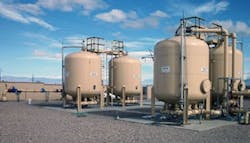Human Factors in the Water Treatment Decision-Making Process
Sahuarita Water Co. (SWC) is a state and federally regulated private water utility dedicated to providing quality drinking water to a 4.7-sq-mile area that includes the master-planned community, Rancho Sahuarita and Rancho Resort. SWC currently employs nine full-time staff with more than 75 years of combined experience in water company operations, administration, maintenance and management.
SWC has been providing drinking water to Rancho Sahuarita and Rancho Resort since 2000. The current service extends to more than 12,000 residents living in more than 4,200 homes; and SWC also provides water to the new Marketplace, the Sahuarita Unified School District campuses in Rancho Sahuarita and the town of Sahuarita Municipal Complex. The source of SWC water is groundwater drawn from the aquifer system below the development. The water system consists of production wells, reservoirs, boosters and other equipment necessary to store and distribute water.
In 2009, SWC installed a 2,000-gal-per-minute Layne Christensen , LayneRT arsenic treatment system, designed to blend and treat three wells to below the U.S. Environmental Protection Agency’s (EPA) maximum contaminant level (MCL) for arsenic of 10 µg/L. The decisions made concerning the design of the treatment system were greatly influenced by human factors affecting SWC, especially those of the served community and the human resource assets of SWC.
In 2008, as water demands increased and in order to comply with the EPA Arsenic Rule, SWC developed a new drinking water well drilled by Layne Christensen . SWC’s two existing operational wells had arsenic levels above the MCL of 10 µg/L: one slightly above the limit, the other with 30 µg/L of arsenic. The company was on a tight timetable to provide the increased supply by the end of the calendar year, and, after deliberating other options, the decision was made to treat all three wells to remove the arsenic. Once treatment had been chosen, the first major decision SWC faced was well head versus centralized treatment. As the supply wells are physically located within the residential community, the company was faced with several important decision criteria that would impact the treatment system design.
Careful Considerations
The safety of the community was the foremost factor and the movement of chemicals to and from the well sites had to be minimized. A second crucial factor concerned the quality-of-life in Rancho Sahuarita, one of Arizona’s premier master-planned communities. Maintenance and waste-hauling traffic would become an immediate distraction in any neighborhood in the community. The third consideration involved the visual aesthetics of the well site, where visible treatment vessels would be deemed a community eyesore. Given these criteria, a centralized system was planned.
The next decision concerned the treatment methodology. SWC was operating smoothly with nine highly-trained staff handling all aspects of the company’s operations. A critical concern was to find a treatment system that could be managed by the existing staff with a minimum of additional labor and training. After evaluating two primary treatment technologies—coagulation/filtration (CF) and adsorption—adsorption was selected due primarily to the low relative maintenance required compared to CF. The company considered CF to be labor intensive with backwashing, chemical treatment and waste disposal issues. Moreover, as the existing staff had little experience in water treatment, and with the very tight timetable imposed on the company (treatment needed to be operational by December 2009, and the contract was to be let in January), the steep learning curve for CF treatment in the limited time window was viewed as a high risk factor by the SWC management team.
Smart Choice
To aid the decision process, the team ran a pilot with two adsorption technologies: LayneRT , a resin-based, regenerable media; and granular ferric oxide (GFO). The pilot results showed GFO breaking through the MCL at 15,000 bed volumes versus LayneRT at 23,000 bed volumes. Besides outperforming GFO in the pilot, another factor also played in favor of LayneRT: As a resin-based media, it does not produce fines, does not need to be backwashed and produces no onsite waste, all factors that reduced maintenance and operator training. The ease of operation of a LayneRT adsorption system as a “simple filter,” as opposed to the complex backwashing needs of a GFO system, matched the minimum staff impact philosophy SWC had adopted for the arsenic treatment system.
Mark J. Seamans is president of Sahuarita Water Co. LLC.
